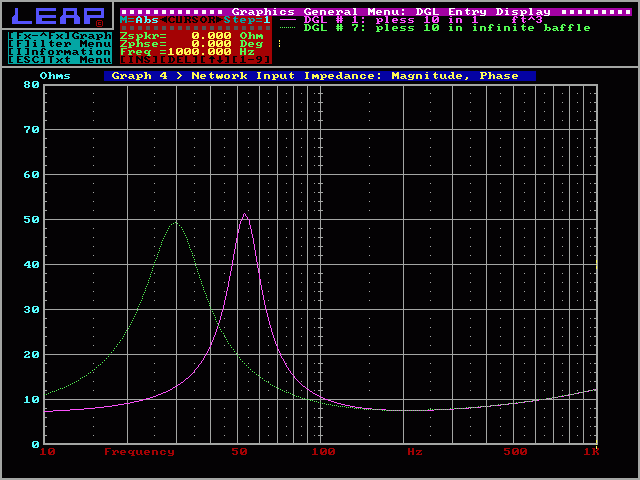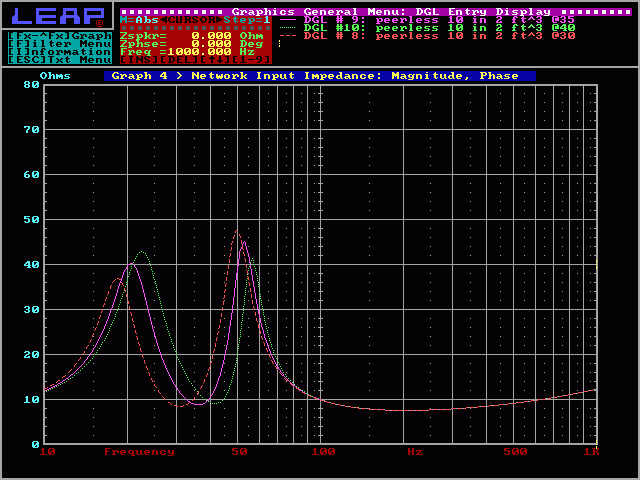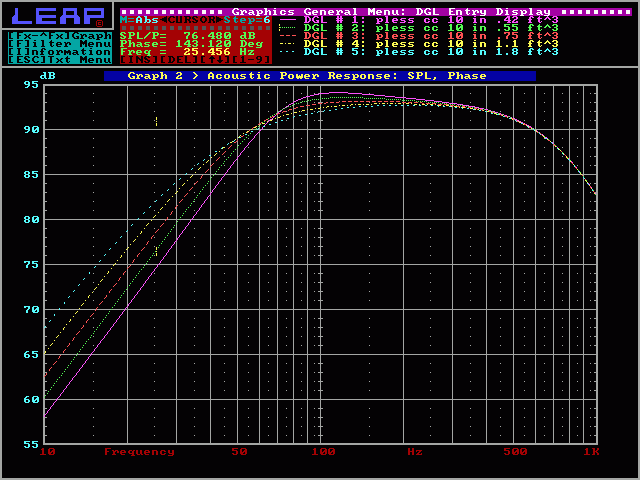|
Understanding the Thiele/Small Parameters
Prerequisites:
If you haven't already read the speakers page of this site. I would strongly recommend reading it before you continue with this page.
fs:
fs is the resonant frequency of a speaker in free air (not in an enclosure). At resonance, the speaker's impedance increases dramatically. The speaker's impedance may go from 4 ohms to more than 20 ohms at resonance. The image below shows how a speaker's impedance changes across the audio spectrum.

Put your mouse/cursor over the different frequencies below the following impedance curve. You can see by the bar graph that the current flow through the voice coil is the least at resonance. The voltage applied to the speaker is constant for all frequencies.

Relative
Current
Flow
Through
Voice Coil
|
|
|
fc:
fc is the resonant frequency of the driver in a sealed enclosure. The fc is higher than the fs with a given driver. The image below shows the impedance curve with a woofer in 1 ft^3 and in an infinitely large enclosure. You can see how the resonant frequency shifts when the driver is mounted in an enclosure. Enclosures of different sizes will produce different resonant frequencies.

This image (below) shows the impedance curve for a ported enclosure. You should notice that, unlike sealed enclosures, the impedance is lowest at the resonant frequency.

Vas:
Vas is the volume of air that has the same compliance as the speaker's suspension. Stiff speakers have lower Vas and tend to use small enclosures. Speakers with loose suspension have a higher Vas and use larger enclosures.
Qes:
Qes is the electrical Q of the speaker and only takes the electrical properties into consideration.
Qms:
Qms is the mechanical Q of the speaker and only takes the speaker's mechanical properties into consideration.
Qts:
Qts is the total Q of the speaker. It is defined as 1/Qts = 1/Qes + 1/Qms.
Qtc:
Qtc is the total Q of the speaker in an enclosure including all system resistances. A Qtc of .707 is the most common and generally produces the flattest frequency response with approximately a 12dB/octave rolloff. Higher values of Qtc will give a peak in the output with a sharper rolloff. A lower Qtc will start to roll off earlier and will roll off at a slower rate. If you don't know what Qtc you need, start with a Qtc of .707.
Violet = Qtc: 0.9; Green = Qtc: 0.8; Red = Qtc: 0.7;
Yellow = Qtc: 0.6; Cyan = Qtc: 0.5;

Vb:
Vb is the net internal volume of the speaker enclosure
EBP:
EBP is the efficiency bandwidth product. It is used as a guide to determine whether a speaker will work better in a ported or sealed enclosure. It is defined as Fs/Qes.
no:
no is the reference efficiency of a driver.
-
This calculator will tell you:
-
Whether the speaker is better suited for a sealed or ported enclosure
-
The 3dB down point of the speaker in either enclosure
-
The recommended volume for sealed and ported enclosures
-
The resonant frequency of both enclosures
-
The port length for ported enclosures
-
The reference efficiency in both % and decibels at one watt
-
If any of the fields return 'NAN' or 'infinity', you did not fill one of the fields required to make the calculations.
Please keep in mind that the data produced by this calculator is simply a guideline. If the manufacturer suggests a particular enclosure, use their recommended design.
-
Notes:
-
The output response curve for the sealed enclosure is determined by the Qtc that you enter.
-
The output response curve for the ported enclosure is going to be a maximally flat design.
|








